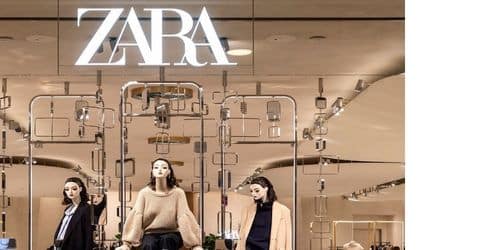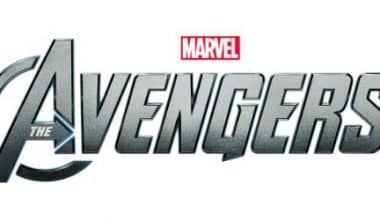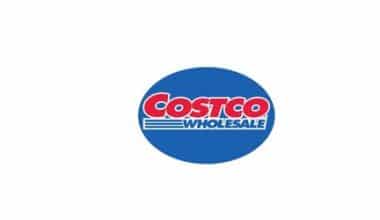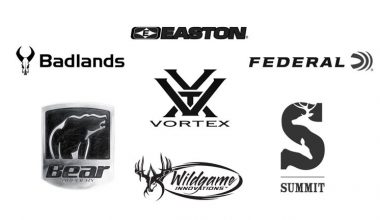Zara has gone a long way since its humble beginnings in 1975, with a budget of only 30 Euros, to becoming one of the world’s most popular fashion brands. Zara is a subsidiary of Inditex, one of the world’s largest distribution companies. From clothing for men, women, and children to shoes, accessories, and other fashion products, it has expanded its variety and reach to approximately 7,000 outlets globally. Let’s go back in history and look at the Zara Fashion Brand and logo success story.
What is Zara?
Zara is a Spanish brand and accessories brand that serves as the Inditex group’s flagship. Few clothing businesses keep up with the latest fashion, are of great quality, and are inexpensive. Zara, the Spanish apparel brand, is likely to have become the go-to fashion brand for all because of the combination of all of these attributes. It is no wonder that Zara, which began as a modest store in Spain, has grown to become the world’s largest retailer, and that its creator, Amancio Ortega, is the world’s fourth richest man.
Zara’s History and Founders
Zara was founded in 1975 as a family business in downtown Galicia, Spain’s northernmost region, by Amancio Ortega and Rosalia Mera. Its original store sold low-cost imitations of popular, higher-end apparel and fashion. Amancio Ortega chose the name Zara because his favorite name, Zorba, was already taken. Zara’s approach to fashion and business model gained popularity with the Spanish customer over the next eight years. This resulted in the creation of nine new outlets in Spain’s major cities.
Inditex was founded in 1985 as a holding company, laying the groundwork for a distribution system capable of adapting to shifting market trends in real time. Ortega developed a revolutionary design, manufacturing, and distribution approach that could shorten lead times and respond to new trends more quickly, dubbed “instant fashion.” This was fueled by significant expenditures in information technology and the use of groups rather than individual designers for the essential “design” element.
Zara rapidly expanded into global markets throughout the next decade, including Portugal, New York (USA), Paris (France), Mexico, Greece, Belgium, Sweden, Malta, Cyprus, Norway, and Israel. Zara stores can now be found in almost every developed country. Today Zara operates 2,264 stores in 96 countries, strategically situated in major cities. It is no wonder that Zara, which began as a modest store in Spain, has grown to become the world’s largest fast fashion retailer and Inditex’s main brand. According to Forbes magazine, its creator, Amancio Ortega, is the sixth richest man in the world.
Other Fashion Labels In Inditex
Inditex is now the world’s largest fashion group, employing over 174,000 people and managing over 7,400 stores in 202 locations globally, including 49 online markets. Inditex’s revenue in 2019 was USD 23.4 billion. Inditex’s other fashion labels are as follows:
- Zara Home is a home goods and decoration company that was started in 2003. Operating in 183 markets, 70 of which have physical storefronts.
- Pull & Bear is a casual, laid-back apparel and accessory brand that started in 1991. It operates in 185 markets, 75 of which have stores.
- Massimo Dutti: Acquired in 1995, high-end apparel and accessories for cosmopolitan men and women. It operates 186 marketplaces, 74 of which have storefronts.
- Bershka, created in 1998, combines urban influences and trendy fashion for young women and men. It operates in 185 markets, 74 of which have stores.
- Stradivarius: Purchased in 1999, casual and feminine clothing for young women. It operates 180 marketplaces, 67 of which have storefronts.
- Oysho was formed in 2001 and specializes in lingerie, casual outerwear, loungewear, and unique accessories. Operating in 176 markets, 58 of which have physical storefronts.
- Uterqüe was created in 2008 and offers high-quality fashion accessories at reasonable pricing. Operating in 158 markets, with stores in 17 of them.
Apart from fashion businesses, Amancio Ortega has established Pontegadea Inversiones, a global real estate investment company that maintains corporate offices in nine countries, including the United States (Seattle), the United Kingdom (London), France (Paris), Canada, Italy, and South Korea. These corporate properties house major corporations such as Facebook, Amazon, and Apple, as well as prominent luxury and retail brands.
Zara’s Brand Strategy
Zara was placed 29th on the list of the best global brands by global brand consultant Interbrand in 2021. Its primary values can be summarized in four words: beauty, clarity, functionality, and sustainability.
Zara’s success has been partly driven by its ability to keep up with rapidly shifting fashion trends and incorporate them into its collections with minimal delay. Zara identified a large market gap that few fashion manufacturers had properly addressed from the start. This was done to stay current with fashion trends while also offering clothing collections that are both high quality and inexpensive. The brand keeps a careful eye on how fashion changes and evolves around the world on a daily basis. It generates fresh designs based on the newest styles and trends and puts them in stores within a week or two. In comparison, most other fashion firms would take close to six months to launch new designs and collections.
Zara was able to outperform other fashion competitors due to its strategic capacity to introduce new collections based on current trends in a timely manner. It immediately became a popular brand, particularly among individuals who desire to stay current with fashion trends. Amancio Ortega, the company’s founder, is well-known for his views on clothing as a perishable commodity. People, he believes, should enjoy using and wearing clothes for a brief period of time before discarding them, much like yogurt, bread, or fish, rather than storing them in cupboards.
According to the media, the Zara fashion brand offers “freshly baked clothing” that last no more than a month or two. Zara focuses on three areas in order to efficiently “bake” its new fashions:
#1. Shorter lead times (and more fashionable clothes):
Shorter lead times enable Zara to ensure that its stores stock clothes that customers want at the time (e.g., specific spring/summer or autumn/winter collections, a recent trend that is catching on, the sudden popularity of an item worn by a celebrity/socialite/actor/actress, a top designer’s latest collection, etc.). While many businesses try to predict what customers will buy months in advance, Zara follows its customers and offers them what they want to buy at any given time.
#2. Lower quantities (through scarcity):
By lowering the quantity created for a specific style, Zara not only decreases its exposure to any single product but also generates fake scarcity. The theory that applies to all fashion goods (and especially luxury) is that the less available an object is, the more desirable it becomes.
Another advantage of creating in smaller quantities is that if a style fails to get momentum and suffers from poor sales, there isn’t a large amount to be disposed of. The Zara fashion brand only has two time-limited sales each year, rather than regular markdowns, and it lowers a very tiny amount of its products, roughly half when compared to its competitors, which is an outstanding effort.
#3. More Styles:
Zara creates more styles, around 12,000 every year, rather than higher quantities per style. Even if a style sells out rapidly, there are fresh styles ready to fill the void. This means more options for the consumer and a better chance of getting it right.
Zara only allows its designs to be displayed in stores for three to four weeks. This strategy encourages customers to return to the brand’s stores because if they were only a week late, all of the garments in a specific style or trend would be gone and replaced by a new trend. At the same time, the regular updating of the lines and styles sold by its stores encourages clients to return more frequently.
Keys To Zara’s Success Story
Here are some of Zara’s supply chain characteristics that illustrate the reasons for its success:
#1. Frequency of Customer’s Insights Collection
Customer insights are collected on a daily basis in a database at the head office, where designers utilize it to create new lines and tweak old ones.
#2. Product information standardization:
Zara warehouses have standardized product information with standardized definitions, allowing for speedy and accurate design preparation with clear manufacturing instructions.
#3. Product information and inventory management:
Zara is capable of designing a garment with an available stock of required raw materials by properly handling thousands of fabric, trim, and design criteria, as well as their physical inventory.
#4. Procurement strategy:
Approximately two-thirds of fabrics are undyed and purchased prior to design completion in order to save money through demand aggregation.
#5. Manufacturing strategy:
Zara has a “make and buy” strategy, in which it manufactures more fashionable and risky things in Spain while outsourcing manufacturing of more standard designs with more stable demand to Morocco, Turkey, and Asia to decrease production costs. The more stylish and risky things (which account for around half of the company’s merchandise) are produced in a dozen company-owned facilities in Spain (Galicia), northern Portugal, and Turkey.
Clothing having a longer shelf life (and thus more predictable demand patterns), such as simple T-shirts, is outsourced to low-cost producers, primarily in Asia. Zara manages to keep costs low even when produced in Europe by outsourcing assembly workshops and using the informal economy of moms and grandmothers.
#6. Distribution management:
Zara’s cutting-edge distribution operation operates with little human interaction. Optical reading machines sort and distribute over 60,000 articles of apparel per hour.
Zara can also change existing items in as little as two weeks, in addition to these supply chain efficiencies. Product life cycle reduction indicates more success in satisfying consumer desires. If a design does not sell well within a week, it is removed from stores, any future orders are canceled, and a new design is developed. Zara actively analyzes changes in client fashion choices. It features a variety of basic patterns that are carried over from year to year, but some in-vogue, high fashion, trend-inspired goods can be on the shelves for less than four weeks, encouraging Zara lovers to return.
A typical high-street retailer in Spain expects customers to visit three times each year, but Zara expects customers to visit 17 times per year. This anticipation for such a high frequency of return visits demonstrates Zara’s confidence in staying on top of evolving consumer demands and preferences, as well as assisting them in shaping their ideas, opinions, and fashion taste. In actuality, Zara helps to birth new trends through its stores, as well as to extend the longevity of some seasonal patterns by selling affordable lines.
#7. Zara’s operations are centered on sustainability:
For the last decade, sustainability has been a hot topic in business, and it is now swiftly becoming a must-have hygiene component for firms that wish to resonate with and win the loyalty of their global customers. Inditex defines this as a dedication to people and the environment.
#8. Commitment to people:
Through professional development, equality and diversity, and volunteering, Inditex guarantees that its workers have a common vision of value based on sustainability. It also ensures that its suppliers have basic workplace rights by launching continuous improvement programs for them.
Inditex also invests more than USD 50 million per year in social and community programs and initiatives. For example, its “for&from” initiative, which began in 2002, has helped persons with physical and mental disabilities integrate into society by giving over 200 steady work opportunities across 15 locations.
#9. Commitment to the environment:
As a company that uses natural resources to generate its products, Inditex works hard to guarantee that its environmental effect is in line with the UN Sustainable Development Goals (United Nations Sustainable Developmental Goals).
Inditex has stated that by 2025, it would only sell sustainable clothing and that all cotton, linen, and polyester sold will be organic, sustainable, or recycled. The company also operates Join Life, a program that assists shoppers in identifying clothing made from more environmentally friendly materials such as organic cotton and recycled polyester.
Inditex also makes extensive measures to maintain biodiversity, decrease the use of water, energy, and other resources, avoid waste, and battle climate change. It has, for example, created a Global Water Management Strategy, particularly committed to zero hazardous chemical discharge. It has also expanded its waste reduction program, which allows consumers to drop off worn apparel, footwear, and accessories at collection sites in 2,299 stores in 46 markets.
Zara’s Culture: Zara does not recognize the term “impossible.”
Zara has a very entrepreneurial culture and hires a lot of young people that swiftly rise through the levels of the company. Zara promotes around two-thirds of its store managers from the inside and has a low turnover rate. The brand has no qualms about entrusting young people with responsibility, and the culture supports risk-taking (as long as learning occurs) and rapid execution (the mantra of fashion).
Top management allows store managers complete freedom and authority over their store’s operations and performance, with clearly defined cost, profit, and growth targets, as well as a fixed and variable reward structure. The variable component accounts for up to half of the overall compensation, making store-level staff highly motivated.
Furthermore, whenever an employee is promoted, his or her shop collaborates with the human resources department to build a complete training program for that individual, which is followed up with periodic extra training – demonstrating Zara’s dedication to talent development. In addition, the organizational structure is flat, with only a few managerial layers.
Customers are Zara’s most essential source of knowledge, but the Zara brand also hires trend analysts, and customer insights experts, and keeps some of the greatest fashion. Zara’s creative team consists of around 200 professionals. They all represent and implement Zara’s company philosophy that the word “impossible” does not exist.
For example, while many companies struggle with long lead times in discussions and decision-making, Zara overcomes this challenge by bringing together various business functions at the headquarters and also by encouraging a culture (via structures and processes) in which people constantly talk to one another. The sales and marketing teams that receive trend input meet with designers and merchandisers on a regular basis.
Read Also: The Most Valuable Fashion Brand In The World
It is critical to have constant two-way communication so that sales and marketing teams may talk to customers about new lines and designers/merchandisers have strong visibility of customers’ requirements and preferences as they are enacted at the shop level. The production schedule is also closely coordinated to ensure that no time is wasted on approvals.
The Zara design team has a relatively flat structure and concentrates on the meticulous interpretation of catwalk trends that are appropriate for the mass market – the Zara customer. Every month, the design and product development teams in Spain collaborate to create 1,000 new styles.
Aside from being customer-centric, another major reason for Zara’s employee strategy’s success is that it allows its employees to make data-driven decisions. Zara does not have a chief designer. All of its designers have unrivaled freedom in approving items and campaigns, which are based on daily data feeds revealing which styles are popular.
Zara’s items are offered in accordance with consumer trends. Its agile supply network delivers new products to retailers twice a week. It takes ten to fifteen days for things to reach retailers after they are designed.
Zara’s Business Holdings
- Zara manages up to 20 clothing designs every year as of 2017.
- Zara is a 100% owned company of the €4 billion Inditex group and is headquartered in Barcelona. Zara’s 600 stores produce more than 80% of the group’s sales. Over 724 stores in 56 countries sell women’s, men’s, and children’s clothing.
- As of 2017, Zara manages up to 20 clothing collections per year.
- Zara currently operates 1,751 stores around the world. They generate almost $9 billion in income each year (2009).
- Its parent company, INDITEX, is 60% owned by the Ortega family, and Inditex generated 6.741 billion in revenue in 2005. Zara has around 2000 thousand branches worldwide. Zara is an apparel distributor.
- On the surface, none of it makes sense. To begin with, the company does not market and still makes the majority of its items in Europe. But when you look at Ortega’s core business, you can realize what a true retail visionary he is. Zara’s business approach was designed from the start with flexibility and speed in mind. The link between the stores, in-house designers, and manufacturing is critical to the company’s success. This has always been an important aspect, along with the company’s excellent logistical management.
- It is because of these essential qualities that he is able to analyze trends and bring them from the catwalk to the high street in a matter of weeks. It took five to six months before Zara arrived. And once we got a taste of what is now known as “quick fashion,” we couldn’t get enough of it.
- The distribution center in Spain handles all of the clothing. New things are examined, sorted, labeled, and placed into trucks. The garment is usually delivered within 48 hours. Zara manufactures around 450 million things each year.
Read Also: EXPENSIVE PURSES: Top 21+ Most Expensive Purse Brands 2022
Zara’s involvement in instilling a much-needed love for fashion has risen since the notion of fast fashion was introduced. In basic terms, Zara has made the top level of fashion something that people from different markets would want or aspire to buy by creating designs that represent the top-level fashion trends that are currently shattering the market. This instills a desire among purchasers with limited purchasing power to possess larger brands. Zara not only promotes great fashion but also keeps its clients content and wanting more at the same time by delighting all of its purchasers in different departments, as evidenced by the way it caters to customers with its TRF collection.
Zara Brand Pricing policy
Zara’s primary business strategy, as previously stated, is to make attractive clothing affordable to all. And the key to this is in their pricing strategy. Prices are often set based on the country, locale, and demand for their items in that area. Because they do not spend money on sponsored promotions or raw ingredients, their products are unexpectedly affordable. They make products in response to the need of their target audience; they set a budget that allows them to choose their materials carefully and continue production. Zara brands its merchandise differently depending on the state or country.
These elements, when combined, enable them to profit depending on the market. Zara offers discounts only once or twice a year due to their low pricing. They think that client loyalty is determined not only by the value of their brand but also by the quality of their products and the unique fashion statement they seek.
Zara Logo Design Elements
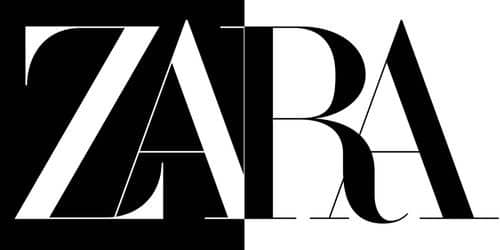
Zara’s logotype is an excellent illustration of a minimal yet effective brand identity. The current wordmark incorporates a bespoke typeface with tall constricted letters interwoven on their bottom sections and the leg of the letter “R” coiled and lengthened. The logo’s dark hue represents the style, elegance, and excellence of Zara’s high-end merchandise. The wordmark is so well-known that, despite being one of the world’s leading fashion houses, Zara does not publicize, relying instead on discount campaigns and its very distinctive corporate identity. At the same time, the Zara logo has been chastised for being extremely plain, generic, and banal.
The Evolution Story of the Zara Logo
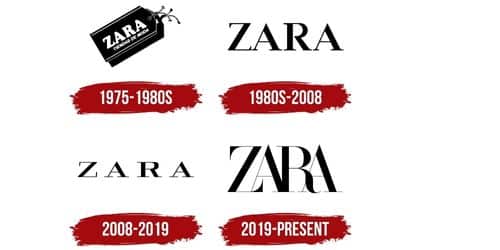
There are not many fashion brands that have such huge global recognition as the Zara logo does. Although the logo has undergone a few changes in its tenure, it has always remained simple and strict to uphold the brand’s iconic presence in the fashion world.
Zara Logo 1975 – 2008
Created in 1975, Zara’s first logo featured a classy and clean serif typeface, executed in a monochrome palette. All capital letters of the wordmark were bold and rightly balanced, and its font was very similar to that of the TT Tsars Bold and Calmius SemiBold, with the curve of the letter “R” slightly modified.
Zara Logo 2008 – 2019
Having existed for around 30 years now, the company now decided to give its logo a new visualization. This was done to make the logo perfectly suitable for printed materials, digital media, product labels, and internal tags. The redesign of 2008 slightly changed the logotype, retaining its previous style and flavor. This time, the letters were placed far from each other, featuring wide and shortened letter shapes. The new square design gives the logo a more confident and serious look, pointing toward the brand’s proficiency, supremacy, and timelessness.
Zara Logo 2019 – Today
Zara once again changed its logo in 2019, retaining the monochrome palette and drawing out the sheriff of the bold alphabets. The existing wordmark goes in a custom font with tall tapered letters entwined on their bottom parts, and the leg of the letter “R” curled and elongated. The font is stretched out and the characters are superimposed on each other.
The New Zara Logo Controversy.
The new logo font is akin to Fabien Baron’s (Baron & Baron creator) distinctive typography, who is also Zara’s artistic director. Baron is also the creative director of several luxury labels, including Dior, Burberry, and Maison Margiela, which may indicate Zara’s desire to restore itself among other high-end fashion houses through rebranding. Zara, as a band formed in the mid-1970s, appears to guarantee its place among the world’s older, more successful companies, rather than among the new generation of regular retail firms.
Fellow designers, particularly typographers, have criticized the revised Zara logo design, calling it “claustrophobic.” Erik Spiekermann, a German typographer who recently collaborated with Adobe to convert unfinished Bauhaus designs into fonts, called it “the worst piece of type [he’s] seen in years” on Twitter. He wondered if it was the work of “one of those new robots that will replace humans.”
Fabio Basile of the British design studio Fortnight also mocked the design with a meme that predicts the Zara logo in the next eight years if the brand continues on its current rebranding path. The revised font type has no space between the letters, with each one directly intertwined with the other, making the logo illegible and confusing. There could be many reasons behind the ideology of the new squashed logo design, but the fact is, the audience loves it (and that’s what matters the most).
Font and Color of Zara Logo
The Zara logo resembles the accessibility of luxury fashion products. Hence, it features only the brand’s name – basic, compact, and comprehensible to all lovers of trending wardrobe items. The current Zara logo design deviates from the contemporary design trends to put up a classic and timeless look – much like many other high-end fashion brands.
Its bold, all-caps logo perhaps indicates something about the company’s ambitions to secure its place amongst the top luxury fashion houses in the world. The iconic black and white combination resembles a much-needed change in the times of ornate and colorful logo designs. It also signifies the availability of fashionable things for everyone.
There are two more logos based on the primary one – one for the men’s collection, and the second one for the Home. The first logo variant is featured in monochrome and has the same spelling as the primary one. Only the word “man” is positioned in the lower right corner and has a different font – bold, sans serif, and a capital “M”.
The latter Home logo is used for home accessories and is made of two parts arranged in tiers – one at the top of Zara and the other one below the word “Home”. Since both words have the same number of characters, they are placed exactly one on top of the other. All the letters share the same width, height, and font. There are no serifs as the emphasis is on practicality rather than style.
Conclusion
For brands like Zara that are not merely profit-centric, the prospect of growth is a piece of cake as their vision revolves around collaborative growth based on smart decisions instead of drastic ones. Keeping true to its unique selling proposition Zara has always kept its customers waiting for new collections that inspire other fast fashion brands that make it stand out in the race of keeping pace with the ever-changing fashion trends around the globe.
Related Articles
- FASHION BUSINESS: Best Ideas, Careers, Names, Courses (+ Startup tips)
- FASHION DESIGN BUSINESS: How to start a home-based fashion design business
- WEBSITES THAT ACCEPT APPLE PAY: All You Should Know and How It Works
- Most Valuable Fashion Brand [3 lessons to learn]
